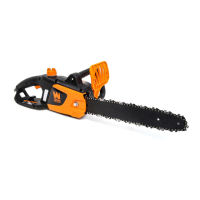15
BUCKING A LOG
Bucking is cutting a log into lengths. It is important to make sure your
footing is firm and your weight is evenly distributed on both feet. When
possible, the log should be raised and supported by the use of limbs,
logs or chocks. Follow these simple directions for easy cutting.
When the log is supported along its entire length (Fig. 12), it is cut from
the top (overbuck).
When the log is supported on one end (Fig. 13), cut 1/3 the diameter
from the underside (underbuck). Then make the finished cut by over-
bucking to meet the first cut.
When the log is supported on both ends (Fig. 14), cut 1/3 the diameter
from the top (overbuck). Then make the finished cut by underbucking
the lower 2/3 to meet the first cut.
When bucking on a slope always stand on the uphill side of the log
(Fig. 15). When cutting through, to maintain complete control, release
the cutting pressure near the end of the cut without relaxing your grip
on the chain saw handles. Don’t let the chain contact the ground. After
completing the cut, wait for the saw chain to stop before you move the
chain saw. Always stop the motor before moving from tree to tree.
NOTE: Never allow the saw chain to contact dirt or soil, doing so will
severely dull the cutting links and shorten the life of the chain.
OPERATION
OPERATION
Cut from top (overbuck), avoid
cutting earth.
Support Log Along the
Entire Length
Support Log on One End
2
nd
cut overbuck
(Ø ²/3) to meet
1
st
cut (to avoid pinching)
1st cut underbuck (Ø
¹/3) to avoid splintering
Log Supported on Both Ends
2
nd
cut underbuck (Ø ²/3) to meet 1
st
cut (to avoid pinching)
1st cut overbuck (Ø ¹/3)
to avoid splintering
Bucking a Log
Stand on uphill side while cutting
because the log may roll.
Fig. 12
Fig. 13
Fig. 14 Fig. 15

